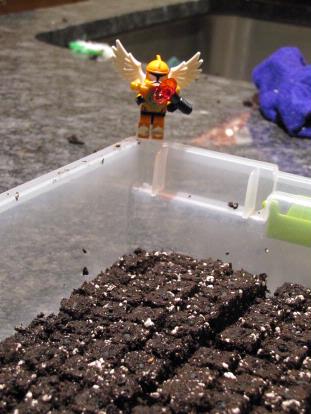Students tend to leave a lot of detritus behind when they leave the lecture hall I teach in. I usually check to see if anything looks valuable; supplementary income always helps. Usually though the debris field consists of oil stained picked over food containers. A few weeks ago as I was leaving I inspected a pile of garbage on a student desk while another student looked on. She sighed and said “I wouldn’t think college students would behave that way.” Clearly she’s new to college. She must have missed when they torched the police car.
This last Monday I found a lovely red egg-shaped object on a desk. It was made of some soothing rubberized plastic and had “eos” written on it. Eos is the Greek goddess of the dawn. I picked it up for further inspection, and noticed a latitudinal seam. I walked down the hallway fussing with my little red dawn egg, trying to pry it apart.
Part way along the hallway, I spotted a student of mine studying and asked if she had any questions. She looked exasperated then glanced at my hands. “Do you know what this object is?” I asked. At that same moment I realized that I needed to twist not pry. The object opened just as she said: “it’s chapstick.” Damn-it. Just to be 100% clear, it was not chapstick which is a trademark of the Pfizer company, it is eos lip balm and “eos” is an acronym for “evolution of smooth,” which doesn’t even mean anything.
I’m quite sure the incident just reinforced preconceptions of college instructors. It also reminded me of an XKCD comic from a few years back. A stick figure pulls on a switch and gets shocked. The comic then shows two possibilities. Nonscientist: “I guess I shouldn’t do that.” Scientist: “I wonder if that happens every time?” I’ve always thought that if the scientist were a tenured professor he/she would actually say “I wonder if this would happen if my research assistant did it.”
Last year I performed a small and poorly controlled experiment on onion seeding. In early March I planted seeds in standard six packs or jiffy pots. In mid-March I followed up with onions from a hastily purchased soil blocker. The seeds germinate in soil blocks then when they’re big enough I pick up the soil block with the included tweezers and drop it into a larger soil block that has a perfectly shaped indentation for the smaller block. No roots are harmed in the process.
There were a number of flaws in my experimental design and implementation. Not least among them was the fact that one of my semi-domesticated yard lions chewed off a bunch of my seedlings. Nevertheless the onions that started in the soil blocks adjusted to transplanting the best and grew like gangbusters. The tool was expensive (probably the equivalent of 15 pounds of onions) but performed marvelously.
So I’m trying it again this year. Sadly I have no research assistant to seed my onions. Instead I recruited the lego angel/stormtroopers you see in the image. They can’t help, but they’re keeping an eye out for droids. Presumably they’ll shoot them with those red things.



